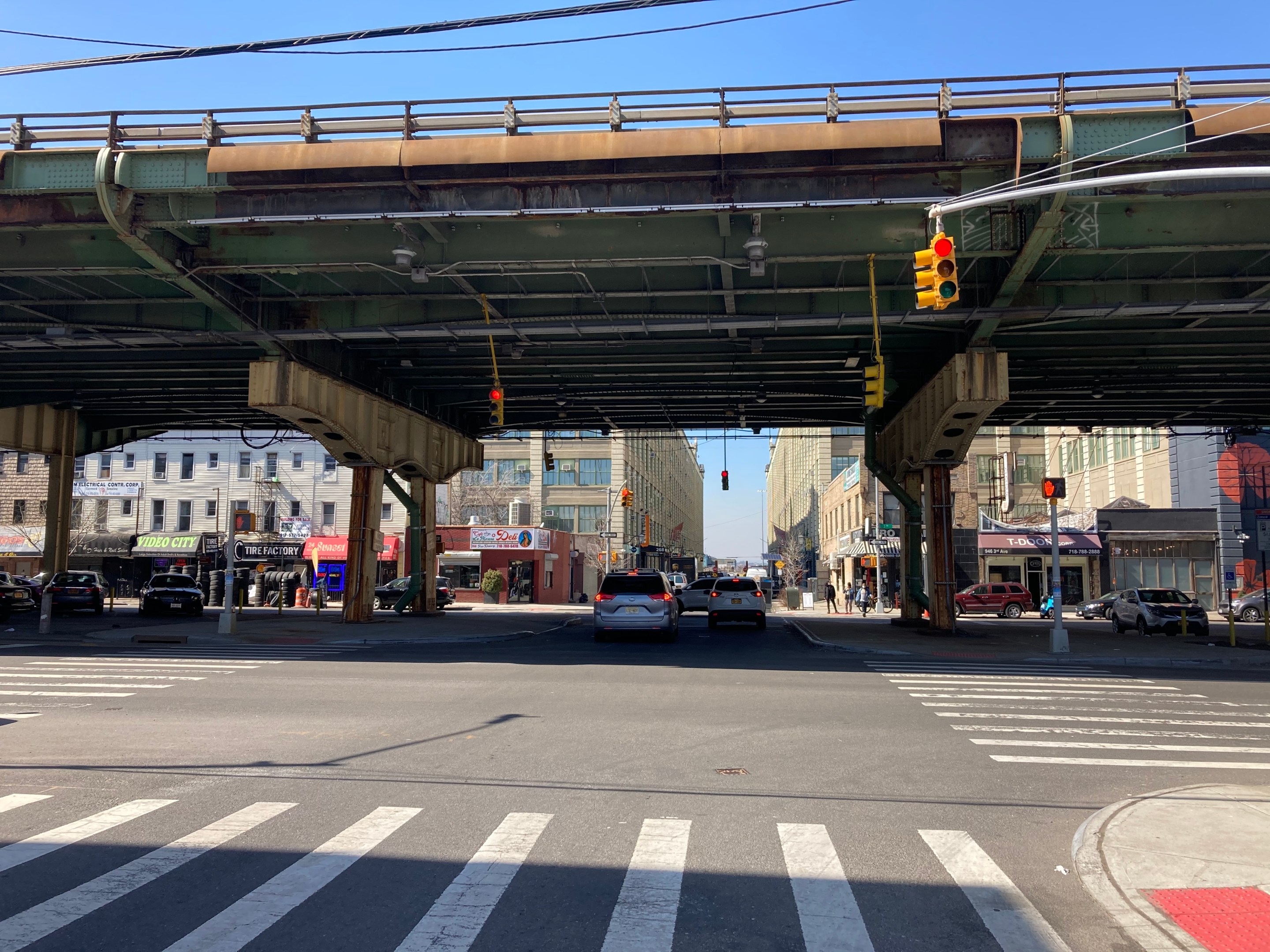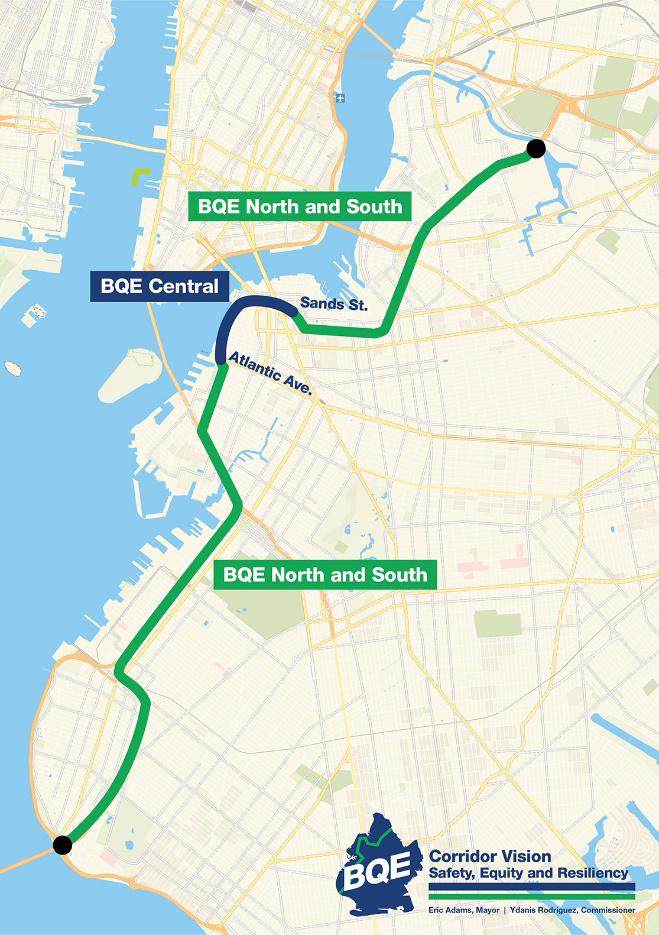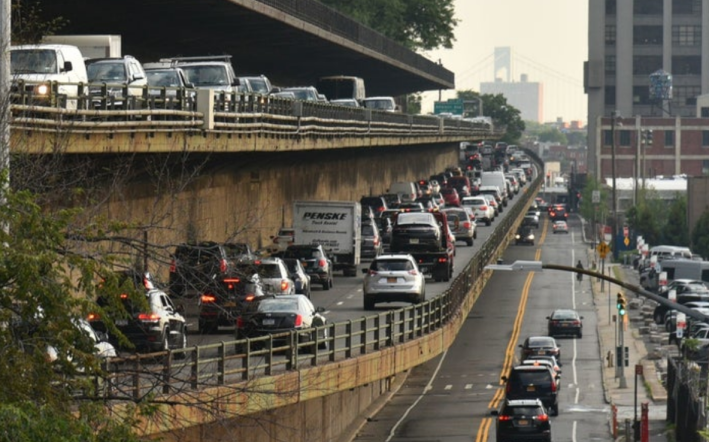The State Has ‘No Plans’ to Redesign the Brooklyn-Queens Expressway
12:01 AM EST on February 9, 2023

The Brooklyn-Queens Expressway cuts through neighborhoods including Sunset Park, shown above. Photo: Julianne Cuba
Gov. Hochul's administration has no intention of addressing the state's portion of the Brooklyn-Queens Expressway — despite pleas from local elected officials and community members desperate to use the opportunity of a forthcoming redesign of the city's portion to scrap the entirety of the antiquated, neighborhood-splicing behemoth.
State DOT has “no plans” to “redesign the state-owned portion of the BQE," spokesman Joseph Morrissey confirmed in an email to Streetsblog last week.
The agency is only providing “technical assistance” to the city as it studies the environmental impact of replacing the 1.5-mile stretch between Atlantic Avenue and Sands Street, including the .4-mile triple cantilever section, Morrissey said.
NYS DOT won't even come to the table on the rest of the corridor — more than 10 miles from Bay Ridge to Queens — according to local pols worried that the communities they represent will be left in the lurch as the city works on the 1.5-mile stretch of the Robert Moses-era highway that has burdened low-income communities of color with traffic and asthma for generations.

“My concern here is that the city of New York has bought into fixing the cantilever, is expending resources and starting the process," said Brooklyn Borough President Antonio Reynoso. "The state hasn't engaged in any way shape or form and has not committed to it."
Pressed at a legislative hearing in Albany on Monday to describe "the state's vision for the BQE," DOT Commissioner Marie Therese Dominguez insisted the state was at the table, but her comments focused solely on the city-owned portion.
The BQE has divided North Brooklyn for generations, causing air and noise pollution in dense residential neighborhoods where a major highway does not belong. I asked @NYSDOT about their vision for this harmful infrastructure—and if they're at the table with impacted communities. pic.twitter.com/1M1yQzLp6v
— Emily Gallagher (@EmilyAssembly) February 6, 2023
"What we're looking at right now is future needs within the city study area," Dominguez told Brooklyn Assembly Member Emily Gallagher, whose Williamsburg district is sliced in half and besieged by cars by the mid-century highway.
Gallagher retorted that her "community doesn't want the BQE repaired, we want it to be revisioned and totally changed."
“There’s been a strong perception in my community that the state is not at that table in the same way the city is in terms of the revisioning of what the BQE can look like. My communities have been divided, we have suffered enormous environmental impacts, we’ve also suffered environmental injustice impacts with childhood asthma,” she said.
"We have trucks and traffic cutting through our residential streets to get to the BQE and I know my community really wants to see a totally different vision."
Another community plagued by the highway along its Gowanus Expressway segment suffers from trucks taking detours down local streets when the BQE is closed on some nights and weekends, according to Brooklyn Assembly Member Robert Carroll, whose district includes portions of Park Slope, Windsor Terrace, and Kensington. Those problems could get worse if the state and the city don’t come together, Carroll warned.
“I’m highly concerned about the BQE. The state and the city need to be working hand in glove. We can’t pass the buck or point at one another,” he said.
Former Mayor Bill de Blasio in 2021 scrapped plans to redesign the highway during his tenure, punting to his successor while promising a “corridor-wide vision for the long-term future” of the highway, the bulk of which remains under state control.
To keep the highway from collapsing, de Blasio proposed an intermittent patch-and-plan, basic maintenance, better monitoring and increased truck weight enforcement. The city also reduced the number of travel lanes on the .4-mile triple cantilever segment.
Mayor Adams in September recommitted to de Blasio's plans to develop a "corridor-wide vision" for the BQE with the goal of “reconnecting communities needlessly divided by the creation of the highway.” In December, the city unveiled its long-awaited plans for the cantilever, all of which would maintain three lanes of traffic in each direction (but with a park on top). The third lane could be designated as a shoulder, for High Occupancy Vehicles or electric vehicles, or for regular traffic, the officials said.
All those plans amount to effectively kicking the "can down the road," said Brooklyn Heights Assembly Member Jo Anne Simon.
“Prior DOT commissioners have in fact told me that. That it was so big, they didn't want to deal with it, and they left it to the next one, who left it to the next one. So I could totally understand why nobody would want to take on that headache because it is enormous,” she told Streetsblog.

Simon's constituents — who successfully stopped previous plans to replace the cantilever that would have required temporarily closing the fabled Brooklyn Heights Promenade above it — are in the same place they've been since the highway was built: Fearful that they will once again get left behind as the city looks to redesign the only portion it owns while the state has no plans for the rest.
“That is, I think, a realistic fear. It is something that has been my concern all along," she said.
But nothing "corridor-wide" on the highway can happen without state DOT, according to the city.
Until then, city DOT's work is limited to the streets it owns around the highway, spokesman Vin Barone said. That includes $500,000 spread across 17 different Brooklyn community organizations to "develop safety and public space projects that reconnect communities that have been separated and devastated by the highway."
“As the Adams administration pursues a long-term fix for BQE Central, including the triple cantilever, we are committed to prioritizing equity, and that means bringing improvements to the entire corridor through Brooklyn," Barone said in a statement.
"We hope to work closely with our state partners as we are with communities in the North and South to plan and deliver these improvements.”
Julianne Cuba joined Streetsblog in February, 2019, after three years covering local news and politics at The Brooklyn Paper. There, she also covered the notoriously reckless private carting industry and hit-and-runs. A 2015 graduate of Stony Brook University’s School of Journalism Master’s Program, she lives in Brooklyn. Julianne is on Twitter at @julcuba. Email Julianne at julianne@streetsblog.org
Stay in touch
Sign up for our free newsletter
More from Streetsblog New York City
Thursday’s Headlines: Speed-Limiting Tech Edition
State Sen. Andrew Gounardes continues his push to force reckless drivers to install speed limiters in their cars. Plus more news.
DOT Official: All Our Free Parking Justifies Keeping Curb Space for EVs
If only someone could do something about the parking!
New York City to Install 500 Secure Bike Parking Hubs In The Next Five Years: Sources
Your bike may finally get a roof over its head.
Adams Backs Lower Speed Limits, Calls Crashes ‘Accidents’
The mayor wants New York City drivers to "slow down," but it's not clear yet how many streets will get lower speed limits.
Wednesday’s Headlines: Trump Posts About Congestion Pricing Edition
Donald Trump comments on congestion pricing — no surprise, he's against it. Plus more news.




